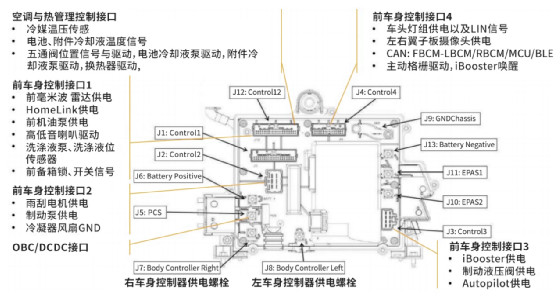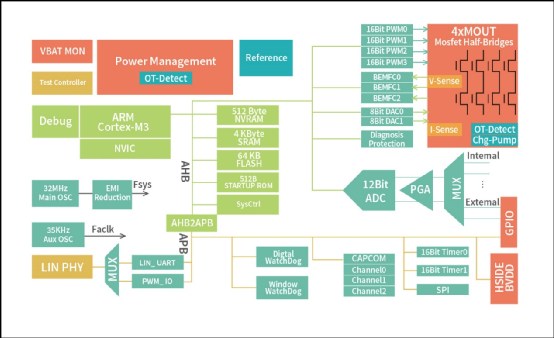Intelligent actuators in the electronic and electrical architecture of the entire vehicle
In the technological transformation of electronic and electrical architecture, the functions of various ECUs on the entire vehicle are redistributed and integrated into domain controllers or central controllers, such as VCUs, BMS, and motor controllers, which are integrated into power domain controllers. The logic of each body control is moved up to the body domain controller, and the parking controller and driving controller are integrated into intelligent driving controllers. Take Tesla as an example. In its latest generation of body control module architecture, three body domain controllers (left and right front) are used to operate most of the actuators on the vehicle, thus eliminating the traditional ECU. The following diagram shows the external actuators controlled by Tesla's front body control panel.

▲ Figure 2 External actuator controlled by Tesla's front body control panel
In such a transformation, there are three issues that need to be addressed at the current stage.
The first issue is that the current architecture of the entire vehicle EE is still undergoing rapid iteration, and some intelligent actuator functions may be temporarily added to new models. The integrated body domain control may not necessarily consider the arrangement of such actuators. For example, some car manufacturers have added the function of automatic charging small doors or rotating large screens, which are not included in the original domain control plan. This requires a simple way to add intelligent actuators.
The second issue is that due to the excessive concentration of integrated domain control functions, the damage of a small component on the domain control board will bring significant maintenance costs, including manual disassembly, fault location, and replacement after-sales costs.
The third issue is the number of wire harnesses. The emergence of domain control in principle aims to reduce the number, weight, and cost of wiring harnesses. However, in fact, due to the need for domain control to directly drive various types of motors and the relatively high driving current, many wiring harnesses that require power need to be removed from the connectors of domain control. In fact, the number and cost of various motor wiring harnesses and connector PIN pins have not significantly decreased, and it also brings the challenge of vehicle EMI.
Under this premise, there is another development perspective in the industry regarding actuators, which is the application of electronic intelligent actuators.
Unlike traditional motor+actuator+ECU architectures, the new generation of electronic actuators often integrate the driving circuit and position feedback directly into the motor mechanism using sensors, making the actuator a miniaturized standard device with LIN bus interface or CAN bus interface, greatly reducing the number of cable connections between traditional ECU and motor actuators.
For example, it is the application of a hidden electronic air outlet in new energy vehicles: an electronic air outlet needs to be installed with two stepper motors in one air outlet to support the swing of the upper, lower, and left and right fans. A car with four front air vents and two rear air vents requires a total of 12 stepper motors to be driven.

▲ Figure 3 Application of Hidden Electronic Air Outlets for New Energy Vehicles
Each stepper motor requires 4 drive wires. If the central domain control scheme is used directly, a total of 48 drive wires are required to control all damper motors, and all of them need to be connected to the output connectors of the domain control. This approach is not optimal in terms of cable cost or system assembly complexity.
If an intelligent actuator is used, the stepper motor and its driver circuit (integrated inside the motor module) will be made into a standard module, leaving only 12V, GND, LIN external signals left_ IN and LIN_ OUT, then use the Bus Shunt Mode (BSM) of LIN to form a cascade, greatly reducing the total number of cables. On domain control, only the corresponding position command needs to be sent on the LIN bus, without the need to pay attention to the drive of the motor and stepper motor. The following figure shows the intelligent actuator module in the electronic air outlet.

▲ Figure 4 Intelligent actuator module in electronic air outlet
From a cost perspective, although having a separate driver for each motor may seem to increase the cost a bit, due to the significant reduction in the number/length of cables and PIN pins of domain control connectors, the overall cost will actually decrease. In addition, the subsequent maintenance costs are greatly reduced because the control part is not on the domain control. This is a good supplement to the body domain control architecture provided by intelligent actuators.
Similar intelligent actuators are widely used in new energy vehicles, such as electronic charging doors, electronic rotary large screen actuators, electronic water valves, AGS, headlight servo, seat ventilation motor control, etc.
The key to electronic actuators is that the electronic control circuit needs to be made very small, which can be embedded in the motor actuator to turn the motor into a standard component that can be directly digitally controlled through LIN or CAN bus. To achieve this, only highly integrated motor control SoC specialized chips can be used.
There are currently not many such chips on the market, such as MLX81332 from Melexis in Belgium or HVC4223 from Micronas in Germany. Fortunately, domestic semiconductor companies have also seen this trend and developed similar SoC chips to fill the domestic gap in this application segmentation field. Currently, they are aware of the NSUC1610, which is a nano core micro chip.
The biggest feature of this chip is that it can be directly powered by a 12V car battery and integrated with an internal power supply. The physical layer of the LIN bus and four half bridge drives can meet the direct driving requirements of DC brushless, DC brushless or stepper motors within 20W. Basically, on a PCB, there is no need for too many peripheral components to directly build a driving circuit for an electronic actuator. Perfectly meeting all the functions required for an electronic actuator.
Driven by highly integrated SoC electronic chips, intelligent actuators in the new EE architecture of new energy vehicles may be a perfect supplement to subsequent body domain control.
- Prev:Shunt voltage regulator alleviates power startup issues
- Next:None
-
Whatsapp

